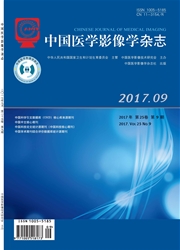

 中文摘要:
中文摘要:
目的探讨MR T1WI动态增强成像半定量和定量分析对中轴骨脊索瘤和骨巨细胞瘤鉴别诊断的价值。资料与方法收集2008年6月—2013年10月于北京大学第三医院放射科进行MR T1WI动态增强扫描并经病理证实的中轴骨13例脊索瘤和17例骨巨细胞瘤患者,对两者后处理分析得到的信号强度-时间曲线类型及应用双室药物代谢动力学分析获得的转运常数(Ktrans)和速率常数(kep)进行统计学分析。结果 13例脊索瘤中,9例(69.2%)为持续上升型,4例(30.8%)为平台型;17例骨巨细胞瘤患者中,11例(64.7%)为速升速降型曲线,6例(35.3%)为平台型曲线。骨巨细胞瘤Ktrans明显高于脊索瘤Ktrans[(0.1247±0.0747)/min比(0.0603±0.0411)/min,P〈0.01];骨巨细胞瘤的kep明显高于脊索瘤的kep[(0.6629±0.2272)/min比(0.1736±0.1184)/min,P〈0.01]。以Ktrans为0.0777/min作为诊断骨巨细胞瘤的阈值时,其诊断的敏感度、特异度分别为89.5%、76.9%;以kep为0.4339/min作为诊断骨巨细胞瘤的阈值时,其诊断的敏感度、特异度分别为94.7%、100.0%。ROC分析Ktrans诊断骨巨细胞瘤的曲线下面积为0.826,kep诊断骨巨细胞瘤的曲线下面积为0.980。结论MR T1WI动态增强成像可以为常规影像学诊断困难的中轴骨脊索瘤和骨巨细胞瘤的鉴别诊断提供一定的参考。
 英文摘要:
英文摘要:
Purpose To investigate the differential diagnostic value of T1WI dynamic contrast-enhanced MRI(DCE-MRI) semi-quantitative and quantitative analysis for giant cell tumors and chordoma in axial skeleton. Materials and Methods Thirteen patients with chordoma and 17 patients with giant cell tumor in axial skeleton confirmed by pathology underwent T1WI DCE-MRI at Department of Radiology, Peking University Third Hospital from June 2008 to October 2013 were envolved. The signal intensity-time curve types after post-processing analysis, Ktrans and kep after two-compartmental pharmacokinetics analysis were analyzed statistical analysis. Results Nine(69.2%) out of 13 cases of chordoma were in "persistent enhancement" type, and the other 4(30.8%) were in plateau type. Among 17 patients with giant cell tumor, 11 patients(64.7%) were in wash-out type, and 6(35.3%) were in plateau type. The Ktrans of giant cell tumor was obviously higher than that of chordoma [(0.1247±0.0747)/min vs.(0.0603±0.0411)/min, P0.01]. The kep of giant cell tumor was obviously higher than that of chordoma [(0.6629±0.2272)/min vs.(0.1736±0.1184)/min, P0.01]. When taking Ktrans of 0.0777/min as the cut-off for diagnosis of giant cell tumor, its diagnostic sensitivity and specificity were 89.5% and 76.9%, respectively; if taking kep of 0.4339/min as the cut-off for diagnosis of myeloma, its diagnostic sensitivity and specificity were 94.7% and 100.0%, respectively. The ROC analysis found that the area under the curve(AUC) of Ktrans for diagnosing giant cell tumor of bone was 0.826, and AUC of kep for diagnosing giant cell tumor was 0.980. Conclusion T1WI DCE-MRI can provide valuable information for the differential diagnosis of giant cell tumors and chordoma when they are atypical and difficult to be identified in conventional imaging.
 同期刊论文项目
同期刊论文项目
 同项目期刊论文
同项目期刊论文
 期刊信息
期刊信息
